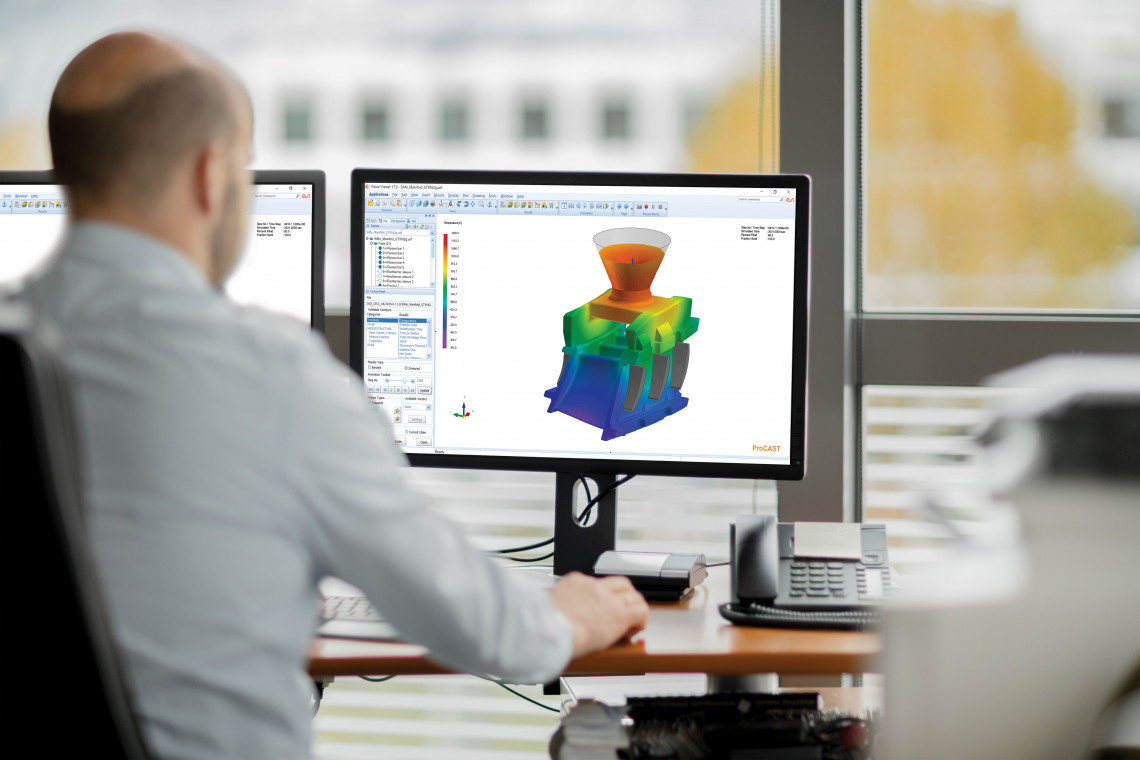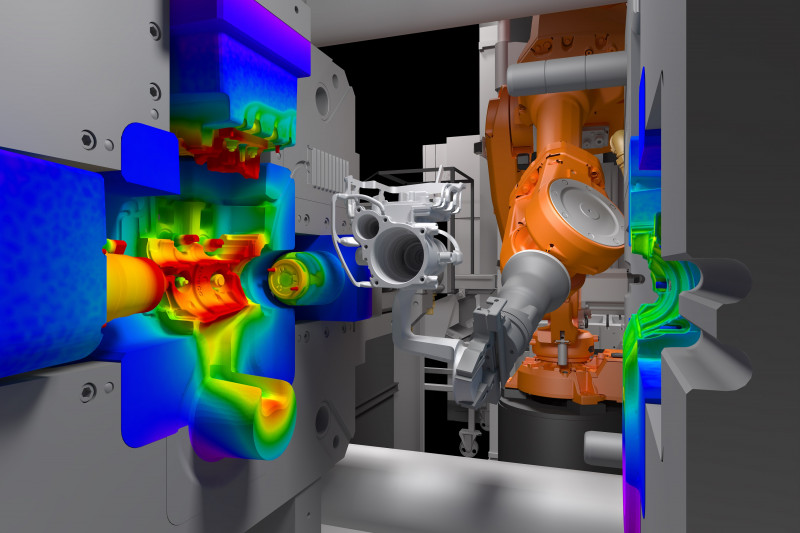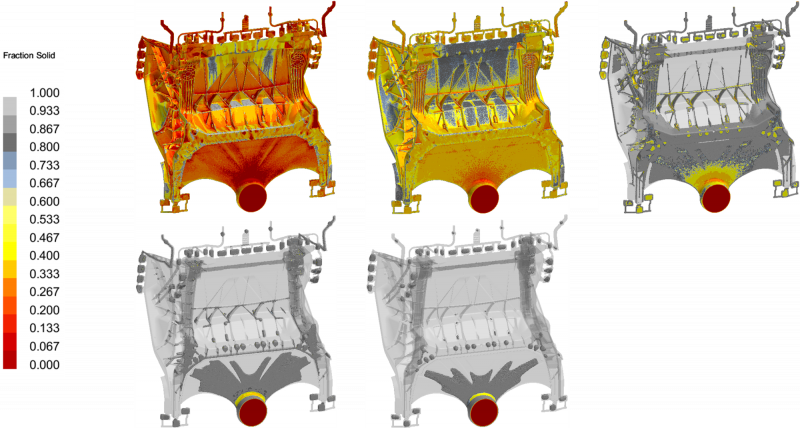How can Casting Simulation Software Benefit Everyone from Small Foundries to OEMs?
Predict Casting Defects Early on to Optimize Casting Processes

Casting is a manufacturing process where a liquid material is poured into a mold, which contains a hollow cavity of the desired shape, and is then allowed to solidify. Casting is often used for making complex shapes that would be difficult or uneconomical to make by other methods.
But the foundry manufacturing process is not without its challenges, ranging from technical to production issues. Technical problems often involve difficulties in achieving the desired part intricacy, or maintaining consistent quality in mass production. The process is also susceptible to various typical casting defects such as shrinkage porosity, air entrainment or distortions, which can compromise the quality of the final product.
Production problems can include high energy consumption and the associated costs. Moreover, foundries constantly strive to improve their product qualities and reduce waste, making process optimization a continual challenge.
Understanding and addressing these challenges is necessary for foundries, regardless of their size, to successfully manufacture components by casting.
What are the Different Types of Casting Processes?
Casting processes can be broadly categorized into various types, each having unique characteristics and requirements:
- Sand Casting: This is the oldest and most traditional casting process where sand is used as the mold material. It's versatile and cost-effective, making it suitable for a wide range of applications.
- Die Casting: Regroups all the processes that uses a permanent metallic mold like low and high pressure casting, gravity, and tilt casting. It can produce fine shapes, with improved mechanical properties and dimensional accuracy.
- Mega Casting (also called Giga casting) is a form of die casting, and produces large-scale, single-piece castings using advanced casting techniques, and is typically for automotive structural components such as vehicle frames or battery enclosures. These castings are characterized by their massive size and intricate geometries, which are often challenging to manufacture using traditional methods.
- Investment Casting: Also known as precision casting, it involves creating a wax pattern, coating it with a ceramic Shell, then melting the wax to leave a ceramic mold for metal pouring. It's known for its ability to produce parts with intricate details and excellent surface finish.
The Role of Casting Simulation Software
Casting simulation software plays a crucial role in the development process of any new casted part, from small independent foundries up to those at large OEMs. It serves as a powerful tool for engineers and technicians to simulate and predict the behavior of molten metal during the manufacturing process. This includes the way the metal flows into the mold, how it solidifies, and cools down.
This advanced technology can streamline the casting process for die casting, sand casting and investment casting processes, and most of their variants. The goal of casting simulation is to ensure the highest degree of process certainty, whilst reducing physical testing, eliminate potential technical problems, and avoid unnecessary costs. Comprehensive modeling capabilities allow for high accuracy and performance. Virtual testing and process optimization even before the actual casting begins, reduces the chance of manufacturing defects and waste.
Such software allows for filling and solidification modeling, helping to identify potential issues and shorten lead times. By predicting where internal defects may occur, modern foundries can shift from conventional trial-and-error to a more proof of concept approach.
Understanding the Process of Casting Simulation
First, a 3D representation of the mold or casting is created within a CAD environment. This model includes all necessary components such as gates, overflow, risers, etc. The CAD file is then opened in the simulation software to be meshed.
Second, material properties of the different volumes (Casting, mold, chill etc..) are assigned. This includes conductivity, density, Solidus and Liquidus temperature and all other relevant properties.
Third, the casting process parameters are set. They are representing the processes done on the shopfloor. These may include the pouring temperature, the flowrate or the velocity at which the material is poured, and the different type of cooling conditions. Once all these have been set, the simulation can be run. The software uses numerical methods to solve the equations that govern the flow of the liquid metal, the heat transfer, and solidification. The output of the simulation typically includes the fill time, flow patterns, temperature distributions, and the location and size of potential defects such as shrinkage porosity or air entrainment.

Filling in Metal Casting Simulations
The filling phase in metal casting simulations is critical, as it may lead to a loss in final part quality. Considering this phase - where liquid metal is poured into the mold - in simulation is vital for predicting the potential issues that can occur during the real casting process.
Casting simulation software provides insights into key aspects of the filling process. These include the flow of molten metal, velocity, pressure, and temperature distribution. Detailed analysis of these results allow for accurate prediction of potential defects such as misrun, air entrainment, oxides, etc…
Furthermore, the software considers variables such as the mold design, alloy properties, and pouring techniques, all of which impact the filling process. By simulating different scenarios, the software allows for optimization of the filling process, ensuring a smooth and complete fill, minimizing casting defects, and ultimately leading to improved casting quality.
Solidification in Metal Casting Simulations

In foundry process simulations, solidification is a key phase that requires careful analysis. Solidification modeling involves scrutinizing how the solidification pattern behaves and if liquid isolated pockets are created. This process is essential as it influences the final structure, quality, and performance of the cast part.
During solidification, several factors come into play including temperature gradients, cooling rates, and mold material properties. Simulation accounts for these variables, providing insights into the solidification behavior of the metal. It can predict areas of the casting that solidify first, and those that solidify last, helping to identify potential hot spots and shrinkage porosity defects.
Advanced simulation software (such as ProCAST by ESI, which will be discussed in more detail later) may also incorporate features to track residual stresses, and predict the microstructure and material properties of the cast part after solidification. This predictive capability allows for proactive measures to be taken to prevent defects and ensure high quality castings.
Can you Simulate the Different Methods of Casting?
The simulation of each of the different casting processes mentioned earlier- sand, die and investment - requires unique parameters and considerations:
Sand casting simulation software
Predicts the filling pattern, solidification, and cooling, highlighting potential defects like oxides or shrinkage porosity. It's crucial in complex molds where sand burning and inclusion/erosion is an important factor to consider. Simulation can also be a key factor to predict core gas.
Die casting simulation software
Simulation assists in optimizing the gating and venting design as well as process parameters like mold temperature, metal pouring condition such as piston velocity curve in High Pressure Casting. The key focus is on capturing the flow dynamics and the impact on part quality.
Investment casting simulation software
Helps in creating the shell and analyzing the mold filling and solidification under gravity or low pressure. The focus lies in predicting the shell temperature and alloy solidification behavior and it’s impact on the final cast.
Each process benefits from casting simulation software, yet the emphasis varies based on the process characteristics. Simulations help in reducing errors and lead times, while enhancing process efficiency and part quality.
What Software is used for Casting Simulation?
ESI ProCAST
With ESI’s proven casting simulation software, ProCAST, manufacturers can cast parts correctly the first time, significantly reducing scrap and late redesigns. ProCAST addresses a wide range of castable alloys and casting processes, including sand casting, die casting, investment casting, and their multiple variants, making it versatile enough to handle even the largest models for mega casting.
As a 2-phase solution, ProCAST accurately considers air and fluid interactions, enhancing its predictive capabilities. Using accurate physics and Finite Element technology, ProCAST predicts complex phenomena, tracks residual stresses throughout the process, and foresees deformations that lead to dimensional variations and reduced die/tool life. Additionally, it computes microstructure, grain structure, and mechanical properties, ensuring that components achieve a longer lifespan and higher performance.
By leveraging ESI's ProCAST software, manufacturers can ensure high precision and reliability in casting processes, reducing waste, minimizing redesigns, and enhancing the overall lifespan and performance of cast components.
To learn more about using simulation software to optimize casting processes, visit the ProCAST webpage.
Katharine Edmonds is a Content Marketing Specialist at ESI Group, and has spent the past 9 years working in marketing and communications for SaaS providers in the engineering and manufacturing industries. Katharine leans on her knowledge and experience of CAD, PLM and eXtended Reality (XR) technologies to create engaging and informative content that champions the benefits of virtual prototyping, and bridges the gap between complex technical subjects and a broader audience.